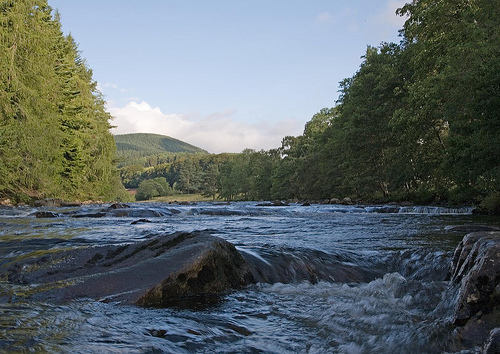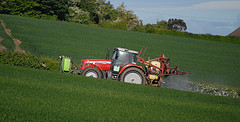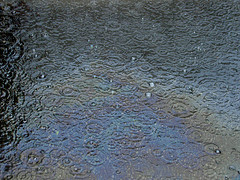Where is the Earth's Water?
 Over 97% of all the water on Earth is salty and most of the remaining 3% is frozen in the polar ice-caps. The atmosphere, rivers, lakes and underground stores hold less than 1% of all the fresh water and this tiny amount has to provide the fresh water needed to support the Earth's population. Fresh water is a precious resource and the increasing pollution of our rivers and lakes is a cause for alarm.
Over 97% of all the water on Earth is salty and most of the remaining 3% is frozen in the polar ice-caps. The atmosphere, rivers, lakes and underground stores hold less than 1% of all the fresh water and this tiny amount has to provide the fresh water needed to support the Earth's population. Fresh water is a precious resource and the increasing pollution of our rivers and lakes is a cause for alarm.
Investigating River Pollution
Most fresh water pollution is caused by the addition of organic material which is mainly sewage, but can also be be food waste or farm effluent. Bacteria and other micro-organisms feed on organic matter and large populations quickly develop, using up much of the oxygen dissolved in the water.
Normally oxygen is present in high quantities but even a small drop in the oxygen level can have a harmful effect on the river animals. Animals can be listed according to their ability to tolerate low levels of oxygen.
In the following list animals which indicate a high level of dissolved oxygen are at the beginning while animals indicating a low level of oxygen are at the end: stone-fly nymphs, mayfly nymphs, freshwater shrimps, freshwater hog lice, blood worms, tubifex worms and rat-tailed maggots.
Other forms of fresh water pollution include micro-plastics, chemicals such as hormones and nasty toxins from household cleaning products.
Microplastics - Fabric particles such as polyester, acrylic and nylon were among the major finds across the samples. Nowadays most of our clothes are made up of these synthetic fibres -researchers have discovered that just one garment can release up to 1,900 microplastic particles per wash!
When swallowed by animals these particles can become lodged in their cells which may cause harm and may also enter the food chain.
See How to Clean Up our Water for twelve handy tips from the Natural Resources Defense Council.
Sampling technique
Choose a place on a river bank which is safe to work from and where there is reasonable access to the water. Push your net through the weeds at the edge of the river and collect any animals hiding there. If the water is shallow you could stand in the river and place your net on the bottom with the opening pointing upstream allowing the current to wash the animals into the net. Tip the catch into a white dish and identify the animals.
If you find only blood worms, tubifex worms or rat-tailed maggots it would suggest that there is little oxygen in the water and that pollution is occurring. If this is the case write to your regional Water Authority informing them of your investigation giving details of where you sampled and what you think might be the possible source of pollution.
Signs of Pollution
If you see dead fish floating on the river or notice that the water is discoloured and smelly any one of the following forms of pollution may be the cause:
- fertilisers
- industrial waste
- oil
- warm water
All incidents of river pollution should be reported to the Pollution Control officer at the Water Authority giving as much detail as you can: date, time, exact place and precisely what you saw.

Fertilisers
If large amounts of fertiliser or farm waste drain into a river the concentration of nitrate and phosphate in the water increases considerably. Algae use these substances to grow and multiply rapidly turning the water green. This massive growth of algae, called eutrophication, leads to pollution. When the algae die they are broken down by the action of the bacteria which quickly multiply, using up all the oxygen in the water which leads to the death of many animals.
Industrial Waste
Chemical waste products from industrial processes are sometimes accidentally discharged into rivers. Examples of such pollutants include cyanide, zinc, lead, copper, cadmin and mercury. These substances may enter the water in such high concentrations that fish and other animals are killed immediately. Sometimes the pollutants enter a food chain and accumulate until they reach toxic levels, eventually killing birds, fish and mammals.
Occasionally poisonous substances are deliberately dumped into rivers and if you see this so-called 'fly-tipping' going on take the registration number of the vehicle and if possible the name of the firm. Report the matter to the police who will then take it further.
 Oil Pollution
Oil Pollution
If oil enters a slow-moving river it forms a rainbow-coloured film over the entire surface preventing oxygen from entering the water. On larger stretches of water the oil contaminates the feathers of water birds and when they preen the oil enters the gut and kills them.
Warm Water
Industry often uses water for cooling processes, sometimes discharging large quantities of warm water back into rivers. Raising the temperature of the water lowers the level of dissolved oxygen and upsets the balance of life in the water.
Warning
When sampling polluted water simple precautions must be taken to avoid getting infected. Packed lunches should be eaten before visiting the river or after washing carefully in a supply of clean water. Rubber gloves should be worn and all the equipment should be thoroughly washed at the end of the investigation.
Credits
Image: River Pollution by Sarah Kanouse
 Over 97% of all the water on Earth is salty and most of the remaining 3% is frozen in the polar ice-caps. The atmosphere, rivers, lakes and underground stores hold less than 1% of all the fresh water and this tiny amount has to provide the fresh water needed to support the Earth's population. Fresh water is a precious resource and the increasing pollution of our rivers and lakes is a cause for alarm.
Over 97% of all the water on Earth is salty and most of the remaining 3% is frozen in the polar ice-caps. The atmosphere, rivers, lakes and underground stores hold less than 1% of all the fresh water and this tiny amount has to provide the fresh water needed to support the Earth's population. Fresh water is a precious resource and the increasing pollution of our rivers and lakes is a cause for alarm.

 Oil Pollution
Oil Pollution